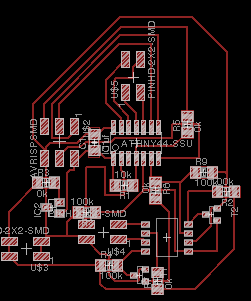When Life Gives You Lemons, Cast Them In Plastic
I ruined my jeans while casting my face in plastic. So I cut up my jeans and cast them into my face using plastic.
Lessons:
- Denim can absorb a LOT of Smooth Cast 327. Make extra.
- Press the fabric firmly into all the cracks and crevices. It's easy to have bubbles.
- USE MOLD RELEASE.
- Acetone will dissolve pink foam. But it also dissolves SmoothCast 327
- Dremmel's are cool.
What we have here is a failure to communicate...


:::LIVE DEMO:::
The schematics and code for these boards will be posted next week. These are the preliminary circiuts I'll use for my final project. One is a sensor board, with input for up to 4 capacitive sensors. It uses a Mega168 for extra memory, so that it can learn statistical models to recognize me. The sensor board also has a button and a header with two serial communication channels.
The other board is designed for output. It has an h-bridge hooked up to the two PWM channels of a tiny84, and an extra pin out for a piezzo buzzer. It's designed to receive a signal from the sensing boards and do something interesting.
Both boards are designed to be modular, meaning that I could build multiple of them and they could communicate with each other. Each one has two separate serial channels. The idea was that one would be used among the sensor boards and one would be used among the output boards. The code is not quite ready for this yet, but hopefully it will be by next time.
Problems:
- H-bridge was backwards. (No dot on schematic OR chip)
- Driving N-MOSFETs were backwards. (S,G and D not labeled in fab library)
- No pull-down resistor on drive line for N-MOSFETs. (Thought pull-ups on P-MOSFETs was enough)
Lessons:
- USE A @#$@# PULL-DOWN RESISTOR ON THE GATES OF ALL YOUR N-MOSFETS!!!!!
- No matter how tempting it is, don't wire your h-bridge from an existing diagram. Think through it yourself.
- If you can't identify S, G and D, stop, take a breath, find a datasheet and START OVER.
- The slanted side of the h-bridge corresponds to the dot on the datasheet (but it's absent in the schematic).
- Before you program, EVERYTHING FLOATS.
- When you plug in your board for the first time, keep your finger on the h-bridge. Be ready to unplug the power quickly.
- When all hope is lost, ask Brian Mayton.
The Final Countdown!!
I'm getting ready to build the anti-theft device for my chair. For starters, I 3D-scanned the back and seat of it. I found out that GeoMagic has some great features for creating a full 3D model out of a bunch of crappy partial point-clouds.
Lessons:
- Put some kind of markers on the thing you want to scan. Make sure they're evenly spaced and easily identifiable.
- Try not to overlap too much - go for maximal coverage.
- Downsample and decimate aggresively. You don't need more than a couple hundred thousand triangles to represent most reasonable shapes.